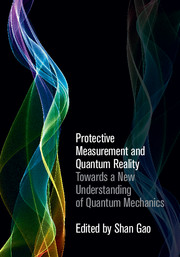Book contents
- Frontmatter
- Dedication
- Contents
- List of Contributors
- Preface
- Acknowledgements
- 1 Protective measurement: an introduction
- Part I Fundamentals and applications
- 2 Protective measurement of the wave function of a single system
- 3 Protective measurement, postselection and the Heisenberg representation
- 4 Protective and state measurement: a review
- 5 Determination of the stationary basis from protective measurement on a single system
- 6 Weak measurement, the energy–momentum tensor and the Bohm approach
- Part II Meanings and implications
- Index
- References
3 - Protective measurement, postselection and the Heisenberg representation
from Part I - Fundamentals and applications
Published online by Cambridge University Press: 05 January 2015
- Frontmatter
- Dedication
- Contents
- List of Contributors
- Preface
- Acknowledgements
- 1 Protective measurement: an introduction
- Part I Fundamentals and applications
- 2 Protective measurement of the wave function of a single system
- 3 Protective measurement, postselection and the Heisenberg representation
- 4 Protective and state measurement: a review
- 5 Determination of the stationary basis from protective measurement on a single system
- 6 Weak measurement, the energy–momentum tensor and the Bohm approach
- Part II Meanings and implications
- Index
- References
Summary
Classical ergodicity retains its meaning in the quantum realm when the employed measurement is protective. This unique measuring technique is re-examined in the case of post-selection, giving rise to novel insights studied in the Heisenberg rep-resentation. Quantum statistical mechanics is then briefly described in terms of two-state density operators.
Introduction
In classical statistical mechanics, the ergodic hypothesis allows us to measure position probabilities in two equivalent ways: we can either measure the appropriate particle density in the region of interest or track a single particle over a long time and calculate the proportion of time it spent there. As will be shown below, certain quantum systems also obey the ergodic hypothesis when protectively measured. Yet, since Schrödinger's wave function seems static in this case [1, 2, 3], and Bohmian trajectories were proven inappropriate for calculating time averages of the particle's position [4, 5], we will perform our analysis in the Heisenberg representation.
Indeed, quantum theory has developed along two parallel routes, namely the Schrödinger and Heisenberg representations, later shown to be equivalent. The Schrödinger representation, due to its mathematical simplicity, has become more common. Yet, the Heisenberg representation offers some important insights which emerge in a more natural way, especially when employing modular variables [6]. For example, in the context of the two-slit experiment it sheds a new light on the question of momentum exchange [7, 8, 9]. Recently studied within the Heisenberg representation are also the double Mach–Zehnder interferometer [10] and the N-slit problem [11]. As can be concluded from [11], the Heisenberg representation prevails in emphasizing the non-locality in quantum mechanics, thus providing us with insights about this aspect of quantum mechanics as well.
Equipped with the backward evolving state-vector within the framework of two-state-vector formalism (TSVF) [12], the Heisenberg representation becomes even more powerful since the time evolution of the operators includes now information from the two boundary conditions.
- Type
- Chapter
- Information
- Protective Measurement and Quantum RealityTowards a New Understanding of Quantum Mechanics, pp. 28 - 38Publisher: Cambridge University PressPrint publication year: 2015

